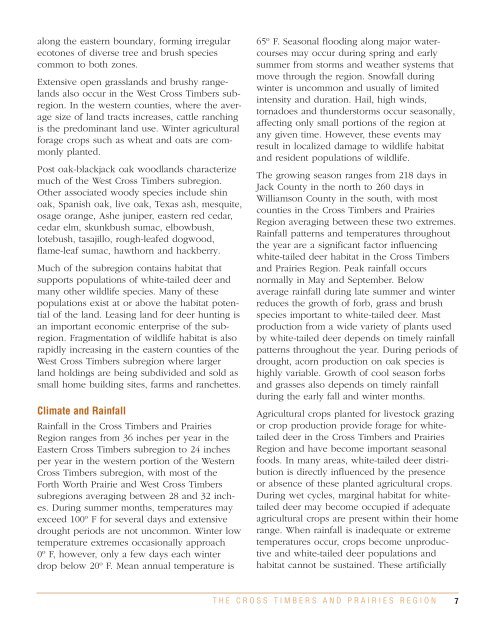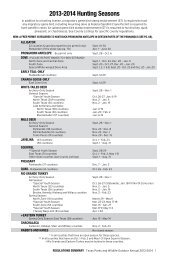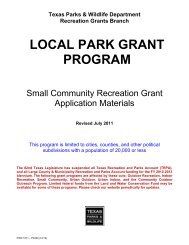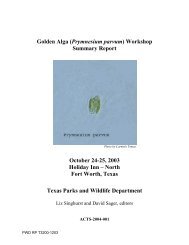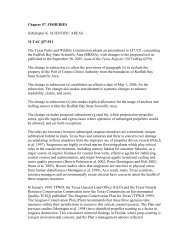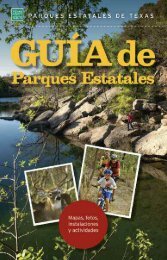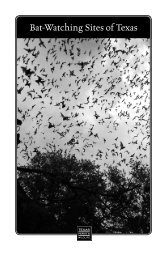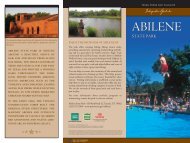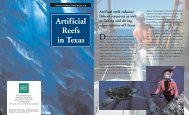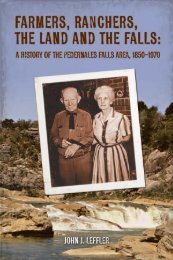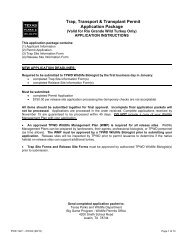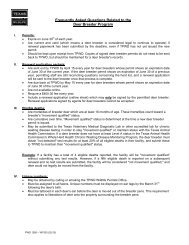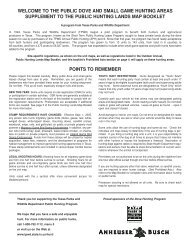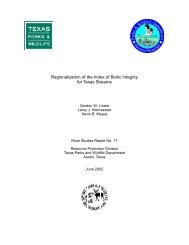White-tailed Deer Food Habits and Preferences in the Cross Timbers
White-tailed Deer Food Habits and Preferences in the Cross Timbers
White-tailed Deer Food Habits and Preferences in the Cross Timbers
You also want an ePaper? Increase the reach of your titles
YUMPU automatically turns print PDFs into web optimized ePapers that Google loves.
along <strong>the</strong> eastern boundary, form<strong>in</strong>g irregular<br />
ecotones of diverse tree <strong>and</strong> brush species<br />
common to both zones.<br />
Extensive open grassl<strong>and</strong>s <strong>and</strong> brushy rangel<strong>and</strong>s<br />
also occur <strong>in</strong> <strong>the</strong> West <strong>Cross</strong> <strong>Timbers</strong> subregion.<br />
In <strong>the</strong> western counties, where <strong>the</strong> average<br />
size of l<strong>and</strong> tracts <strong>in</strong>creases, cattle ranch<strong>in</strong>g<br />
is <strong>the</strong> predom<strong>in</strong>ant l<strong>and</strong> use. W<strong>in</strong>ter agricultural<br />
forage crops such as wheat <strong>and</strong> oats are commonly<br />
planted.<br />
Post oak-blackjack oak woodl<strong>and</strong>s characterize<br />
much of <strong>the</strong> West <strong>Cross</strong> <strong>Timbers</strong> subregion.<br />
O<strong>the</strong>r associated woody species <strong>in</strong>clude sh<strong>in</strong><br />
oak, Spanish oak, live oak, Texas ash, mesquite,<br />
osage orange, Ashe juniper, eastern red cedar,<br />
cedar elm, skunkbush sumac, elbowbush,<br />
lotebush, tasajillo, rough-leafed dogwood,<br />
flame-leaf sumac, hawthorn <strong>and</strong> hackberry.<br />
Much of <strong>the</strong> subregion conta<strong>in</strong>s habitat that<br />
supports populations of white-<strong>tailed</strong> deer <strong>and</strong><br />
many o<strong>the</strong>r wildlife species. Many of <strong>the</strong>se<br />
populations exist at or above <strong>the</strong> habitat potential<br />
of <strong>the</strong> l<strong>and</strong>. Leas<strong>in</strong>g l<strong>and</strong> for deer hunt<strong>in</strong>g is<br />
an important economic enterprise of <strong>the</strong> subregion.<br />
Fragmentation of wildlife habitat is also<br />
rapidly <strong>in</strong>creas<strong>in</strong>g <strong>in</strong> <strong>the</strong> eastern counties of <strong>the</strong><br />
West <strong>Cross</strong> <strong>Timbers</strong> subregion where larger<br />
l<strong>and</strong> hold<strong>in</strong>gs are be<strong>in</strong>g subdivided <strong>and</strong> sold as<br />
small home build<strong>in</strong>g sites, farms <strong>and</strong> ranchettes.<br />
Climate <strong>and</strong> Ra<strong>in</strong>fall<br />
Ra<strong>in</strong>fall <strong>in</strong> <strong>the</strong> <strong>Cross</strong> <strong>Timbers</strong> <strong>and</strong> Prairies<br />
Region ranges from 36 <strong>in</strong>ches per year <strong>in</strong> <strong>the</strong><br />
Eastern <strong>Cross</strong> <strong>Timbers</strong> subregion to 24 <strong>in</strong>ches<br />
per year <strong>in</strong> <strong>the</strong> western portion of <strong>the</strong> Western<br />
<strong>Cross</strong> <strong>Timbers</strong> subregion, with most of <strong>the</strong><br />
Forth Worth Prairie <strong>and</strong> West <strong>Cross</strong> <strong>Timbers</strong><br />
subregions averag<strong>in</strong>g between 28 <strong>and</strong> 32 <strong>in</strong>ches.<br />
Dur<strong>in</strong>g summer months, temperatures may<br />
exceed 100º F for several days <strong>and</strong> extensive<br />
drought periods are not uncommon. W<strong>in</strong>ter low<br />
temperature extremes occasionally approach<br />
0º F, however, only a few days each w<strong>in</strong>ter<br />
drop below 20º F. Mean annual temperature is<br />
65º F. Seasonal flood<strong>in</strong>g along major watercourses<br />
may occur dur<strong>in</strong>g spr<strong>in</strong>g <strong>and</strong> early<br />
summer from storms <strong>and</strong> wea<strong>the</strong>r systems that<br />
move through <strong>the</strong> region. Snowfall dur<strong>in</strong>g<br />
w<strong>in</strong>ter is uncommon <strong>and</strong> usually of limited<br />
<strong>in</strong>tensity <strong>and</strong> duration. Hail, high w<strong>in</strong>ds,<br />
tornadoes <strong>and</strong> thunderstorms occur seasonally,<br />
affect<strong>in</strong>g only small portions of <strong>the</strong> region at<br />
any given time. However, <strong>the</strong>se events may<br />
result <strong>in</strong> localized damage to wildlife habitat<br />
<strong>and</strong> resident populations of wildlife.<br />
The grow<strong>in</strong>g season ranges from 218 days <strong>in</strong><br />
Jack County <strong>in</strong> <strong>the</strong> north to 260 days <strong>in</strong><br />
Williamson County <strong>in</strong> <strong>the</strong> south, with most<br />
counties <strong>in</strong> <strong>the</strong> <strong>Cross</strong> <strong>Timbers</strong> <strong>and</strong> Prairies<br />
Region averag<strong>in</strong>g between <strong>the</strong>se two extremes.<br />
Ra<strong>in</strong>fall patterns <strong>and</strong> temperatures throughout<br />
<strong>the</strong> year are a significant factor <strong>in</strong>fluenc<strong>in</strong>g<br />
white-<strong>tailed</strong> deer habitat <strong>in</strong> <strong>the</strong> <strong>Cross</strong> <strong>Timbers</strong><br />
<strong>and</strong> Prairies Region. Peak ra<strong>in</strong>fall occurs<br />
normally <strong>in</strong> May <strong>and</strong> September. Below<br />
average ra<strong>in</strong>fall dur<strong>in</strong>g late summer <strong>and</strong> w<strong>in</strong>ter<br />
reduces <strong>the</strong> growth of forb, grass <strong>and</strong> brush<br />
species important to white-<strong>tailed</strong> deer. Mast<br />
production from a wide variety of plants used<br />
by white-<strong>tailed</strong> deer depends on timely ra<strong>in</strong>fall<br />
patterns throughout <strong>the</strong> year. Dur<strong>in</strong>g periods of<br />
drought, acorn production on oak species is<br />
highly variable. Growth of cool season forbs<br />
<strong>and</strong> grasses also depends on timely ra<strong>in</strong>fall<br />
dur<strong>in</strong>g <strong>the</strong> early fall <strong>and</strong> w<strong>in</strong>ter months.<br />
Agricultural crops planted for livestock graz<strong>in</strong>g<br />
or crop production provide forage for white<strong>tailed</strong><br />
deer <strong>in</strong> <strong>the</strong> <strong>Cross</strong> <strong>Timbers</strong> <strong>and</strong> Prairies<br />
Region <strong>and</strong> have become important seasonal<br />
foods. In many areas, white-<strong>tailed</strong> deer distribution<br />
is directly <strong>in</strong>fluenced by <strong>the</strong> presence<br />
or absence of <strong>the</strong>se planted agricultural crops.<br />
Dur<strong>in</strong>g wet cycles, marg<strong>in</strong>al habitat for white<strong>tailed</strong><br />
deer may become occupied if adequate<br />
agricultural crops are present with<strong>in</strong> <strong>the</strong>ir home<br />
range. When ra<strong>in</strong>fall is <strong>in</strong>adequate or extreme<br />
temperatures occur, crops become unproductive<br />
<strong>and</strong> white-<strong>tailed</strong> deer populations <strong>and</strong><br />
habitat cannot be susta<strong>in</strong>ed. These artificially<br />
THE CROSS TIMBERS AND PRAIRIES REGION 7


